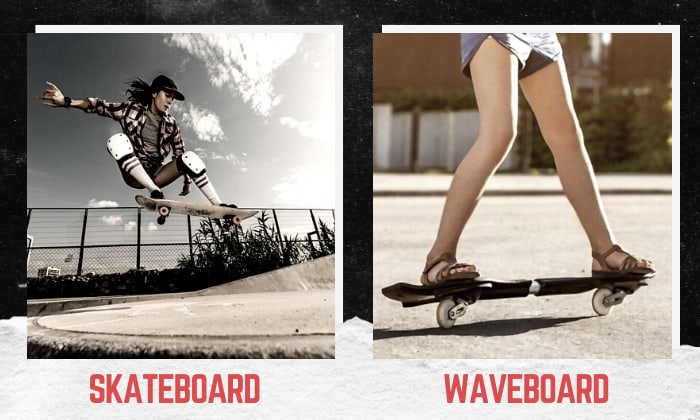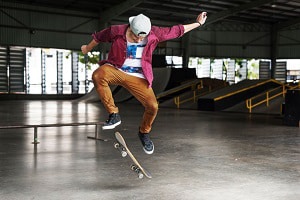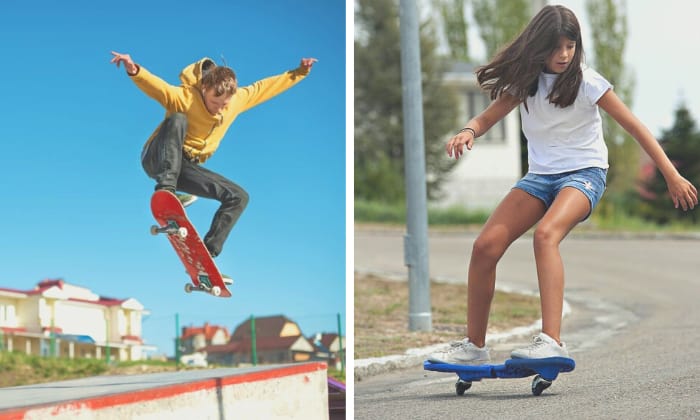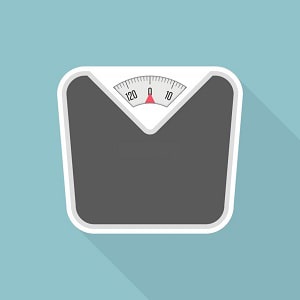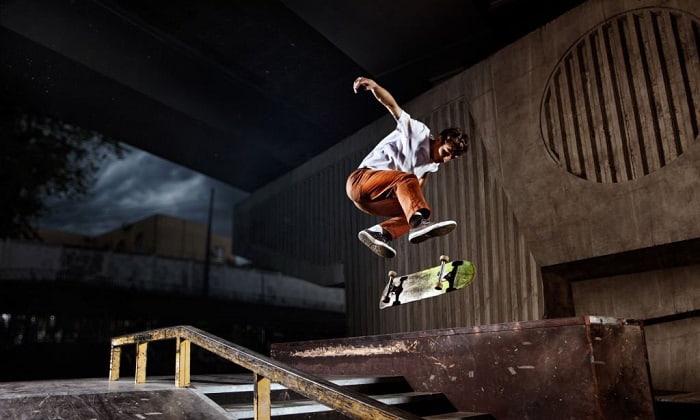Anyone who loves the outdoors could come across various street sporting equipment like skateboards, roller skates, or wave boards. And among these items, each stands out in a single aspect or two.
Let’s take skateboard VS waveboard, for example. These boards may be the two most popular pieces of equipment among teens of different generations. They might look similar, but there are differences the naked eye cannot recognize immediately.
So, in this article, we will learn about these pieces of equipment, their differences, and how they work.
| Skateboard | Waveboard |
| More parts (four wheels, bearings, spacers, etc.) | Fewer components (two wheels with decks and torsion bar) |
| Better for high speeds | Easier to maintain stability |
| The high number of tricks | Fewer stunts to execute |
| Requires pushing | No pushing necessary |
| Heavier | Lighter |
| Burns more calories | Helps riders stay fit but may be less intensive |
Table of Contents
Skateboards and Waveboards: Defined
1. Skateboard
As we know, skateboards are the popular wooden planks installed with a pair of trucks and four wheels. After years of development, maple and bamboo boards also emerged, making skateboards more sustainable.
And today, we already have different types of skateboards for beginners, adults, and professionals, making the sport more inclusive.
Through skateboards for technical skating, users ride on the roads, streets, skate parks, and other urban obstacles.
But if you don’t want to flip decks, a skateboard for long distances like a longboard will help you.
2. Waveboard
A wave board, or caster board, is like a two-wheeled skateboard divided into two decks conjoined by a torsion bar. And below each of these decks is a wheel that rotates 360°.
This type of board moves without constant pushing from the feet. Riders only press their feet front and back in unparallel directions to move.
It sounds challenging, but wave boards have traction pads to secure the rider’s shoes when skating.
3. How skateboards and wave boards work
Skateboards and wave boards might look pretty straightforward, making many believe that they work the same way. Unfortunately, that’s not how things are.
Skateboarders often begin with the basics, like identifying the appropriate footing and pushing the board. Users place their dominant foot on the deck while the other foot pushes against the ground. Eventually, they put both feet on the board once the wheels move.
Succeedingly, skaters will proceed to do tricks on the streets, pump, grind against rails and ledges, or slide down ramps.
Read more: Basic guide to skateboard
On the other hand, a wave board depends more on the swiveling of the feet and all other movements.
When using a wave board, the riders stand with their dominant foot at the front. Subsequently, the feet initiate the swiveling by wiggling in opposite directions, while leaning both feet forward will reduce speed.
And as an effect, the wave board moves forward without the rider having to push it.
Differences Between a Skateboard and Waveboard
Besides the differences in the riders’ motions in riding skateboards and wakeboards, there are more distinctions we should also learn.
1. Calories burned
Fitness-centered people will likely check this aspect first before anything else. Between skateboarding and waveboarding, which sport burns more calories?
For the record, wave boards help riders lose 174 to 407 calories an hour.
That’s pretty high, but how many calories does skateboarding burn per hour? Skateboarding goes slightly higher at 300 to 575 per hour.
But while both boards help users lose weight, we should note what systems they work on and assess which sport suits our goal more. Essentially, wave boards enhance cardio health, while skateboards focus more on muscle building and strengthening.
2. Safety
Caster board VS skateboard, which is safer?
Both can expose you to the same kinds of injuries. However, because wave boards are inherently more stable than skateboards, you may have more trouble avoiding falls and scrapes on a skate deck.
At high speeds, though, wave boards are more risky if you’re a beginner who’s unused to using both feet.
3. Wheels
The wheels translate the movements of the rider. Are these parts the same between skateboards and wave boards? No.
The only similarity between wave board and skateboard wheels is that they come from polyurethane.
Waveboards only have two wheels, one on each end of the board. Each roller mounts against a caster, allowing it to rotate 360°.
Meanwhile, skateboards are like cars in the number of wheels. Each wheel sits on four axle pins shared by two trucks. But besides the wheel, skateboards also employ bearings, washers, and spacers on the same axles.
4. Weight
Which is lighter, a skateboard or a wave board?
With wave boards having only two wheels, they are considerably lighter. Also, these boards aren’t extravagant in internal parts. Hence, they’re less dense.
On the other hand, skateboards are generally heavier. Why? The four wheels and their interiors alone yield the differences. Plus, the solid trucks add more weight to them.
5. Learning curve
Waveboarding has a faster learning curve than skateboarding.
Many will say that skateboards take much time to learn and master. And that is because of these reasons.
- Riders move, turn, and stop manually.
- Weight management is crucial.
- Balancing is a pivotal factor.
On the other hand, wave boarding is easier to learn because of its improved stability and the ability of the decks to twist into opposing directions.
6. Performing tricks
Of course, the thrill remains relevant, whether skateboarding or wave boarding. And such an aspect often becomes noticeable when we do tricks.
But How Are Skateboard Tricks Different From Waveboard Tricks?
Skateboarding offers a wide array of stunts. These skills begin from the basics, such as ollies and kick turns. By the time the skater gains more experience, he can do the more complicated skills, like flips and 900s.
This aspect is where a wave board becomes limited. With only two wheels available, wave board users are only likely to notch the following.
- Double kickflip
- Pop shove-it
- Frontside 180 double kickflips
- Manuals
- Varial heelflips
Pros and cons
Let’s now summarize the great and not-so-desirable things about skateboards and wave boards.
Waveboard
- Faster to learn
- Lighter than skateboards
- Limited tricks variety
Skateboard
- Move variety in tricks
- More skateboarders are around
- Heavier due to more and denser parts
Cost
Are you thinking about how much these boards cost? Let’s see some skateboard and wave board prices today.
Skateboards
1. ANDRIMAX Complete Skateboard for Beginners – $37.99
2. Ryvorbe Skateboards for Beginners – $39.99
3. Magneto SUV Skateboard – $99.99
Waveboards
1. Oxelo waveboard 120 – $55.85
2. Magnitt Deluxe Junior Caster Board – $59.98
3. Decathlon waveboard Oxeloboard – $82.97
Which one should you choose?
Now that we know about the advantages and benefits of skateboards and wave boards, we can finally decide which is better.
If, as a rider, you want more stability and sharp turns, wave boards will work best. But if you plan to execute a more thrilling ride, skateboards are the way to go. You can do more tricks and play with ramps with other skaters in the community.
But do note that wave boarding roots mostly from the basics of skateboarding. Hence, mastering a skateboard first could help you learn wakeboards faster, allowing you to hit two birds with one stone.
Frequently Asked Questions
Are waveboards and RipStiks the same?
Many will propose that a wave board VS RipStik bears no difference because of their plastic build, torsion bar connections, and riding style. However, there are a few deviations.
First, whether it’s a RipStik for beginners or for adults, this board type exhibits a consistent array of solid-colored decks, less flashy than a waveboard’s appearance.
Second, both boards differ in deck shapes and grip surfaces. Third, wave boards have 77mm wheels, 1mm bigger than RipStik rollers.
There’s not much difference between wave board and RipStik tricks because both function the same.
Which is more difficult, wave board or skateboard?
Having discussed both boards, we can infer that wave boarding and skateboarding are connected activities, and you can benefit from learning one immediately after another. But between these, is wave board harder than skateboard? No. But how?
The constant need to balance, manage your weight, and overall skill execution is a hump for every skateboarder. Nonetheless, there is nothing consistent practice can’t address.
Is Waveboarding easy?
Yes, wave boarding is easy, but only if you are knowledgeable of and already doing skateboarding.
Waveboards often yield stability for the rider. And for someone who has mastered the same skill in skateboarding, obtaining balance on a wave board would be easier.
Conclusion
With the continuous improvement of outdoor sports and activities, we can’t negate how the equipment we use also keeps evolving.
This skateboard VS wave board comparison shows that each piece of equipment is unique, and we can develop something positive from it. These benefits could be physical, mental, and even social.
All we should do is learn how these items work, how they differ, and assess what will bring us the most advantage. By then, we’ll be making the best of our spending.

Hi, I am Charles Harris. I opened this site to write as much as I can about my biggest passion – skateboarding!
I started as a clumsy yet passionate rookie 10 years ago to now a still passionate yet much better skateboarder! But I have to tell you, the whole journey has always been fun and rewarding, indeed not without hardship.


